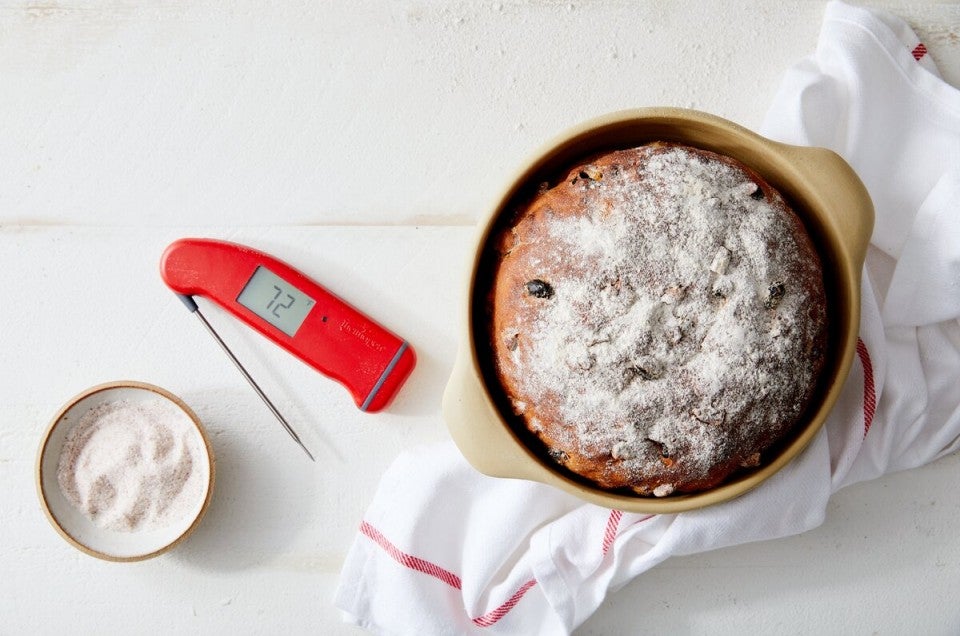


THUMP THUMP THUMP. Yeast bread bakers have traditionally tested their loaves for doneness by tapping on the bottom and listening for a distinctive hollow thump: a perfectly good method. But for those of us who don't like juggling blistering hot loaves in order to get at their bottoms for the thump test, there's another method: taking the bread's internal temperature. Using a thermometer with yeast bread not only saves you the "hot potato" juggle, it offers excellent guidance — if you know how to interpret your temperature results.
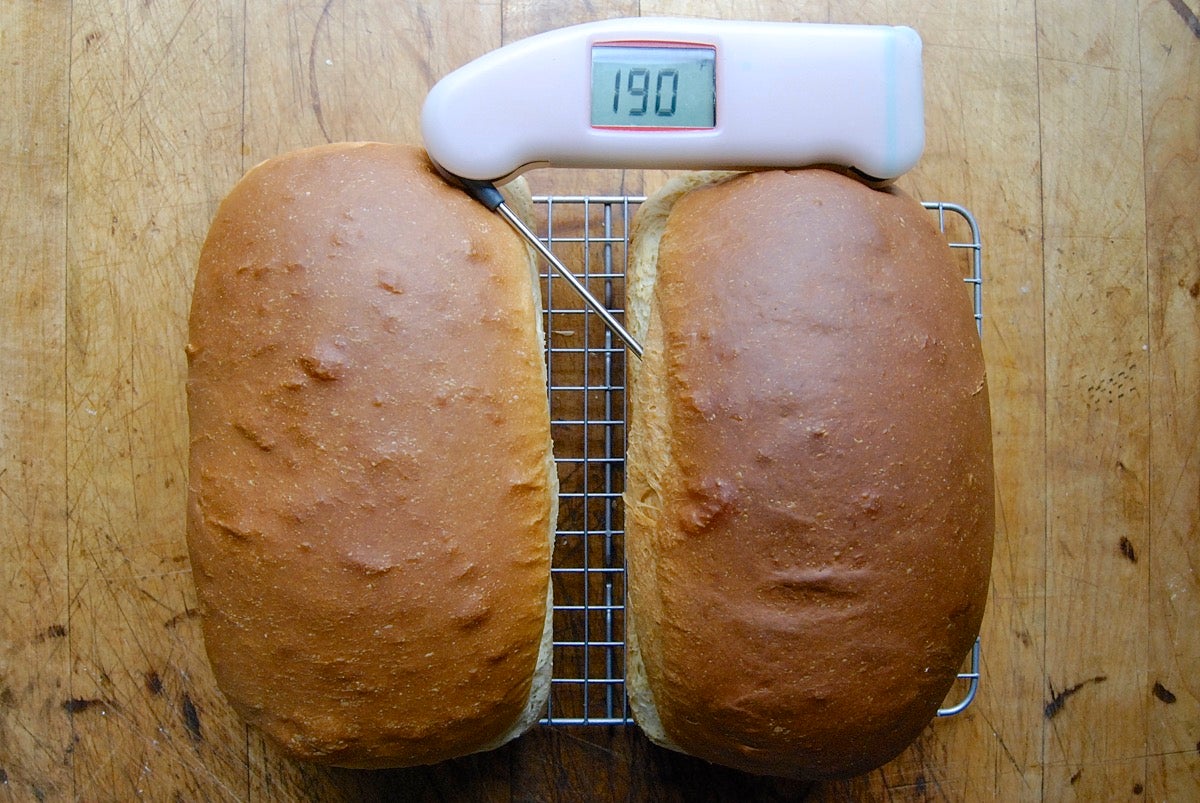
You may notice that many of our King Arthur Flour yeast bread recipes call for the perfectly baked loaf to reach an internal temperature of 190°F. And honestly, this is a good benchmark. Most loaves and rolls will indeed be done when they register 190°F at their center.
But some breads — baguettes, for instance — need to reach a higher internal temperature to be fully baked. And some bakers argue that large, dense/hearty whole grain rounds should be baked to an internal temperature of 205°F to 210°F, in order to ensure they're completely baked at the center.
I recently baked an array of yeast breads, taking their temperature (at the center of the loaf) in 5-minute increments towards the end of their bake and detailing the results. Bottom line: 190°F is indeed a good benchmark. Every loaf I baked — except for the baguettes — cooled to an excellent texture when brought to 190°F during baking. Still, I discovered some interesting things along the way. Let's check out the tests.
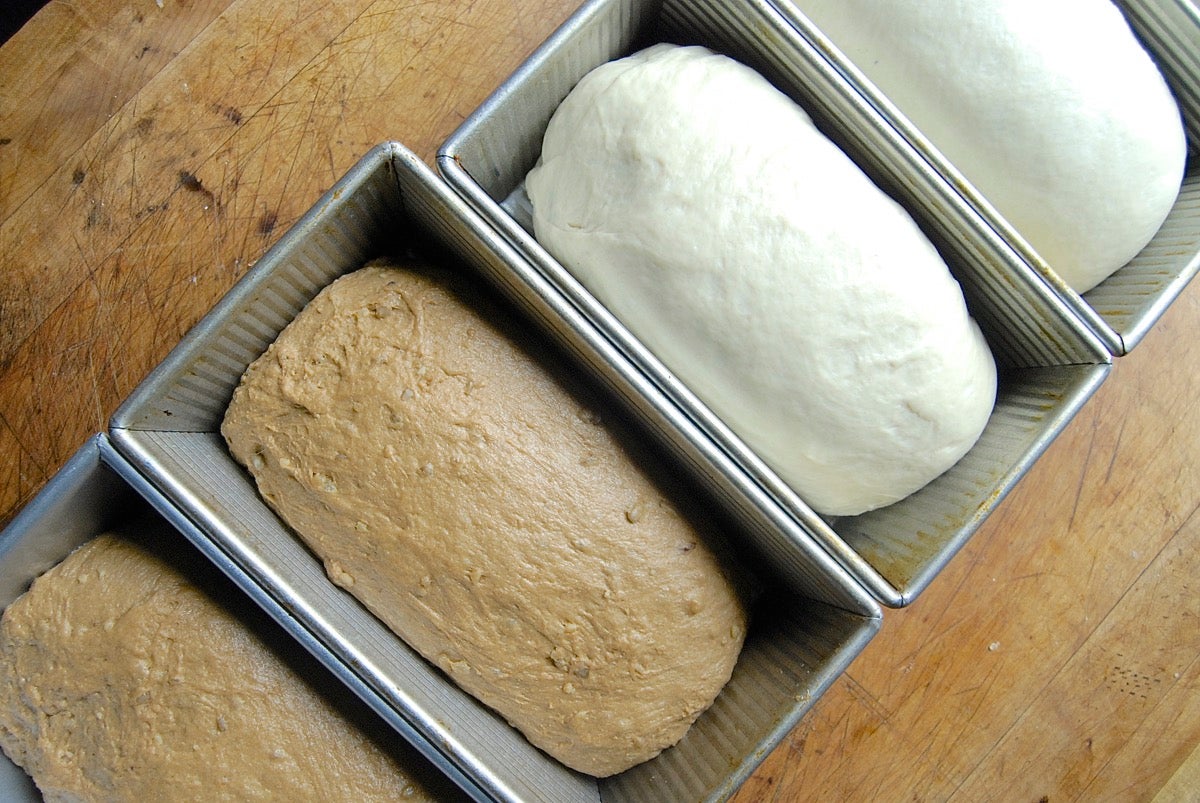
Here's the dough for two of my favorite sandwich loaves: Classic Sandwich Bread, and 100% Whole Wheat Sandwich Bread. Each makes a close-grained, tender, moist sandwich loaf.
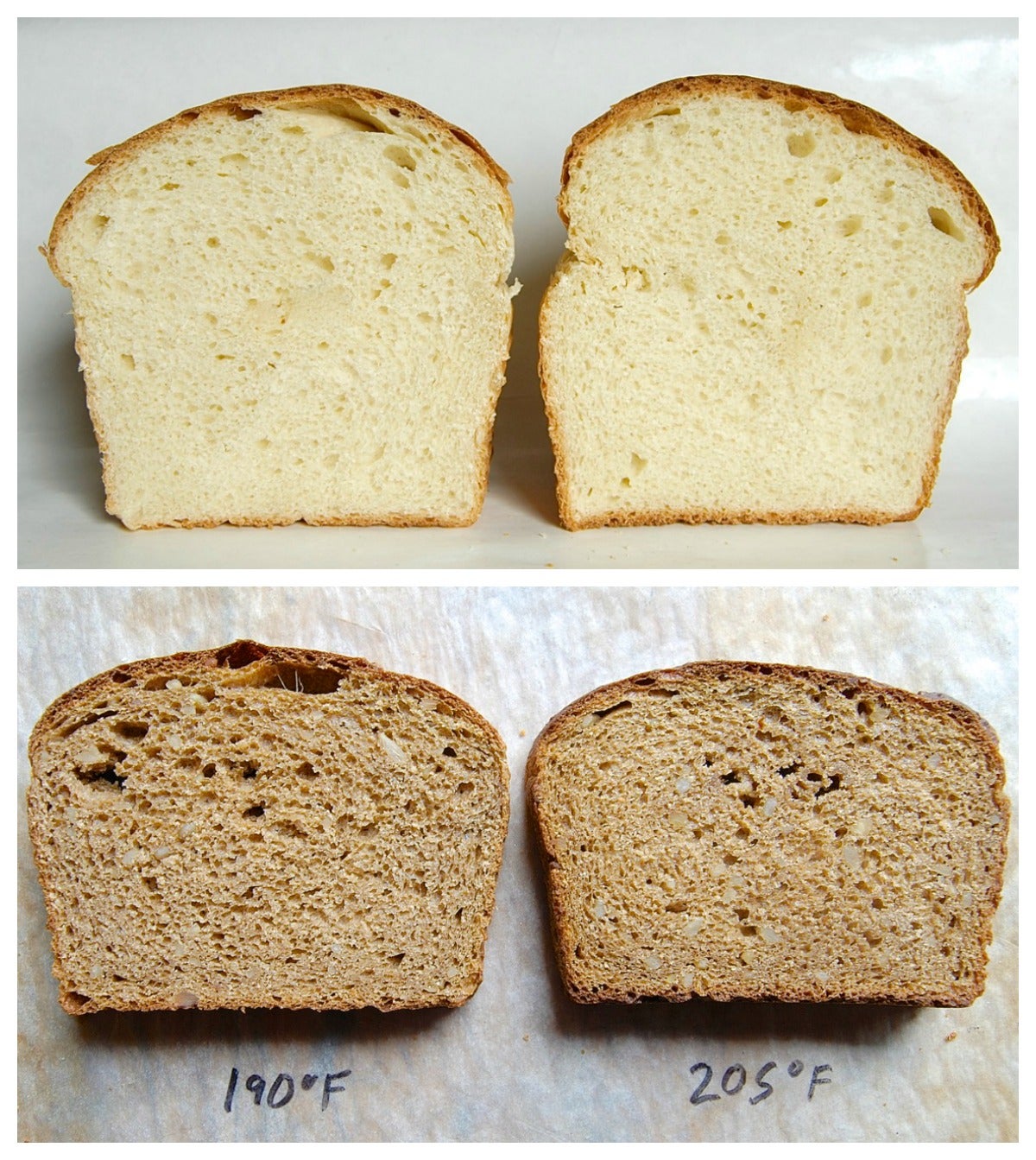
For each bread, I bake one loaf to 190°F, one to 205°F. Once cool, I slice the loaves right through the center, to make sure I'm seeing the point where any under-baking would have happened.
Loaves baked to each temperature look similar at the center; the only visual difference is the slightly thicker crust on the loaves baked to 205°F.
Sampling the loaves, though, there's a noticeable difference in texture. The 190°F loaves are moister and softer; the 205°F loaves, drier. And after a couple of days, the 190°F loaves still retain some moisture — making them seem fresher.
Verdict: Pan bread (sandwich loaves) are fully baked, yet still nicely moist and tender, when baked to 190°F.
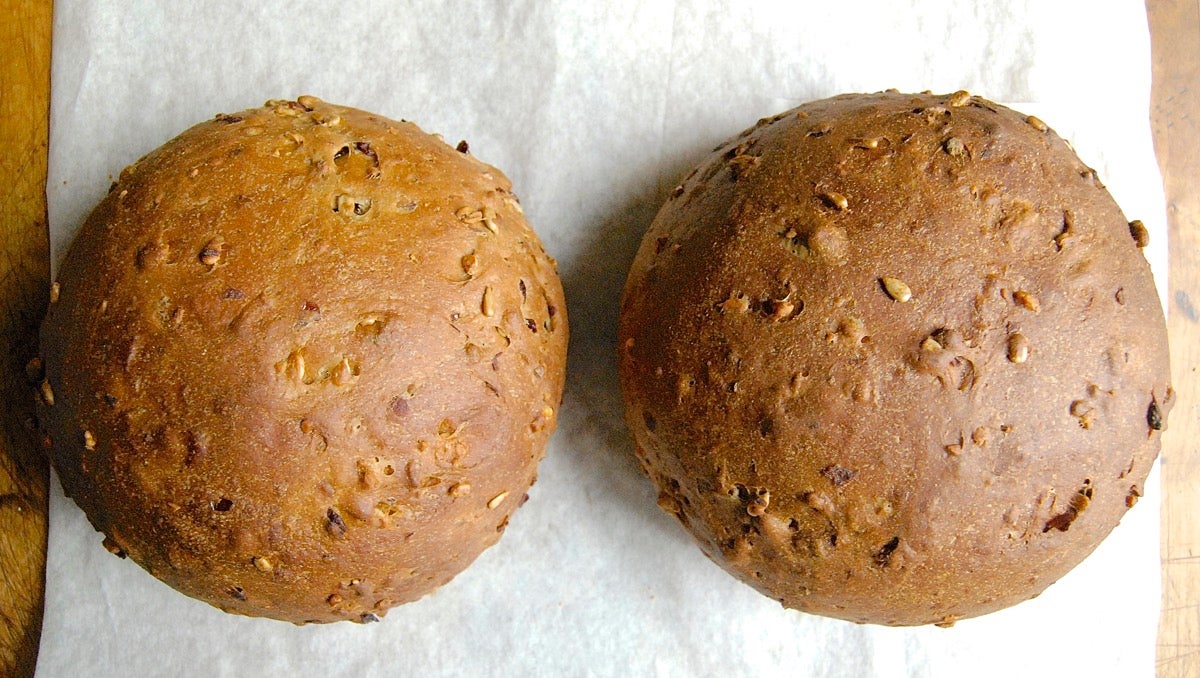
Easy Granola Bread is a good example of a loaf that might be difficult to bake to the correct doneness without using a thermometer.
It's a dark loaf to begin with, thanks to the whole-grain flour, so it's hard to gauge how done it is by its crust color. Add its dense texture, and its shape — there's no bread where the center is farther from the edge than a round boule — and you've got a baking challenge.
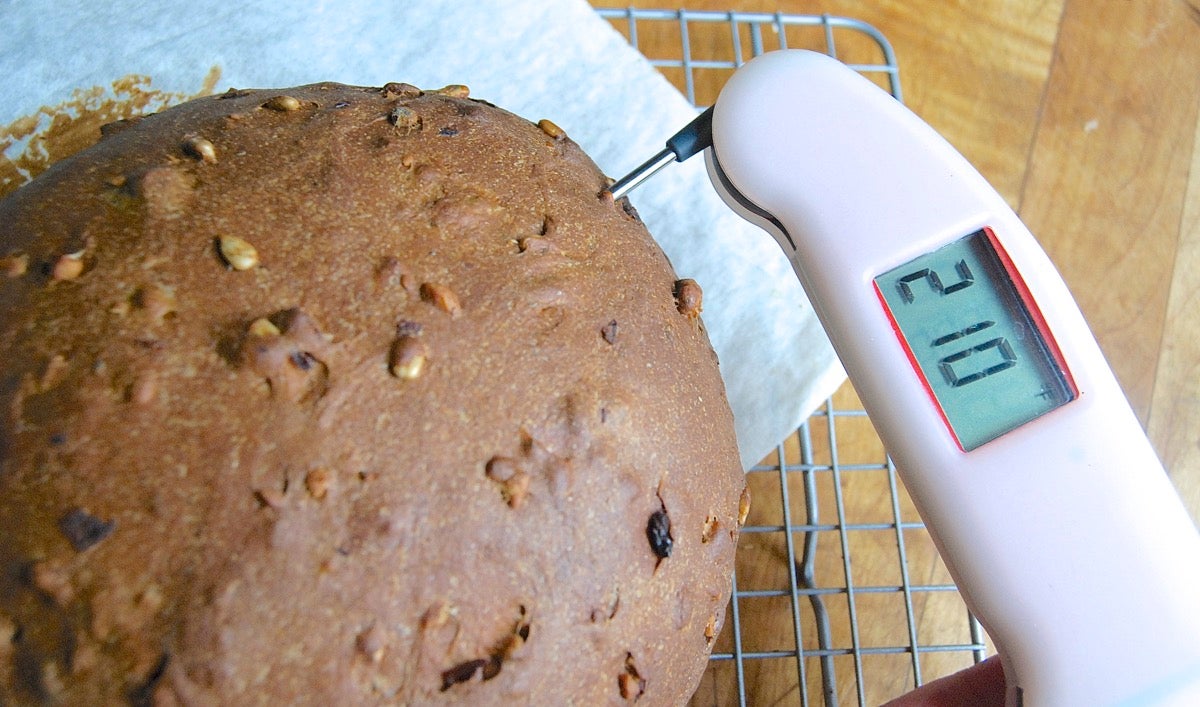
I bake one loaf to 190°F, the other to 210°F — the temperature many bread bakers claim is optimum for this type and shape of loaf, given the need to ensure it's fully baked all the way to the center.
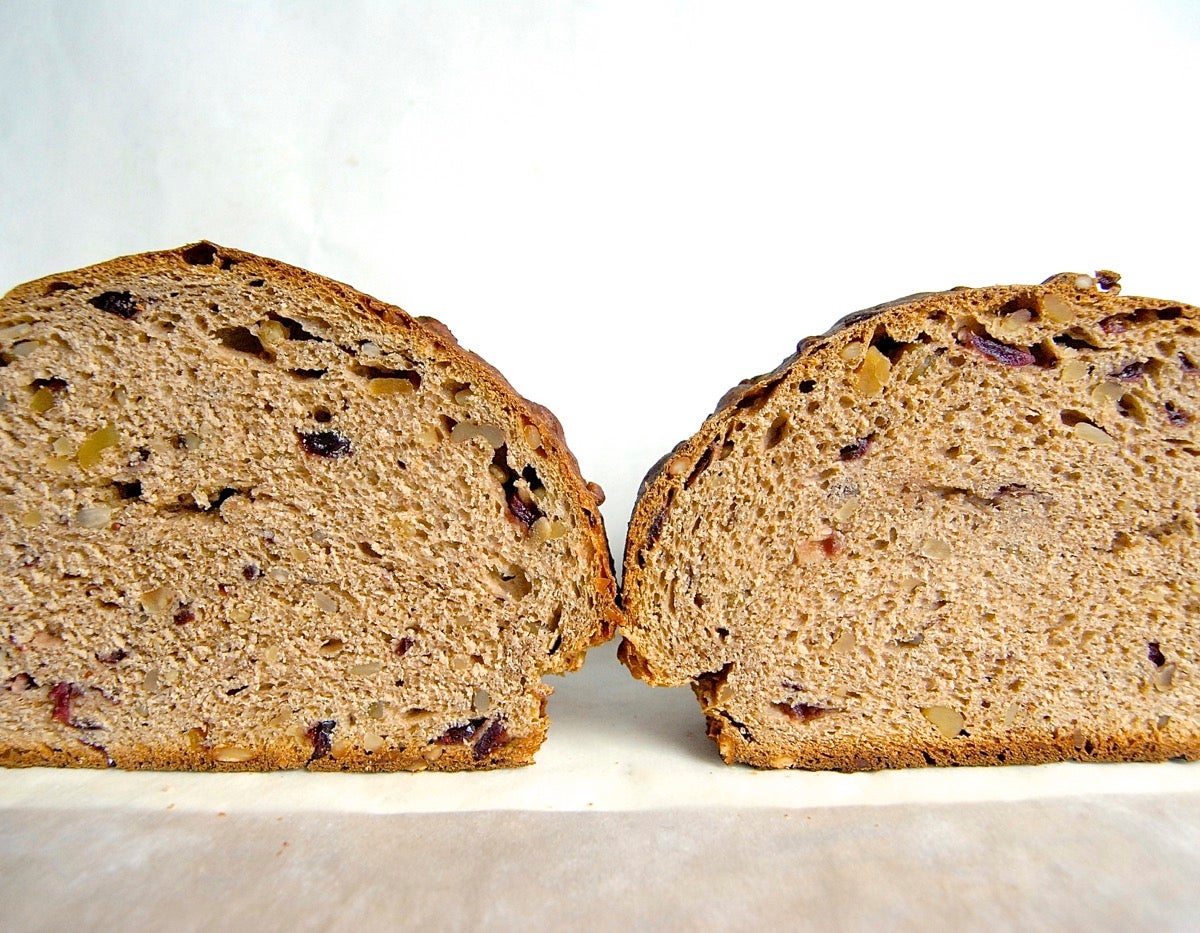
The result? Just like the previous test, these loaves are similar in appearance. The center of the 190°F loaf (pictured at left) isn't gummy/under-baked. But again, once I taste the two side by side, the 190°F loaf is definitely moister, its crust less tough. And it stays softer as time goes by.
Verdict: Even a large, fairly dense whole grain loaf is fully baked at 190°F. I enjoy a soft, moist, tender loaf, so the 190°F bread is my favorite. If you like your whole-grain bread drier/chewier, bake it longer — but baking to 210°F isn't necessary to prevent under-baking.
Let me just add that I LOVE this bread for its mild yet rich flavor: vaguely nutty, somewhat grain-y. And its texture is nearly cake-like — it's that tender.
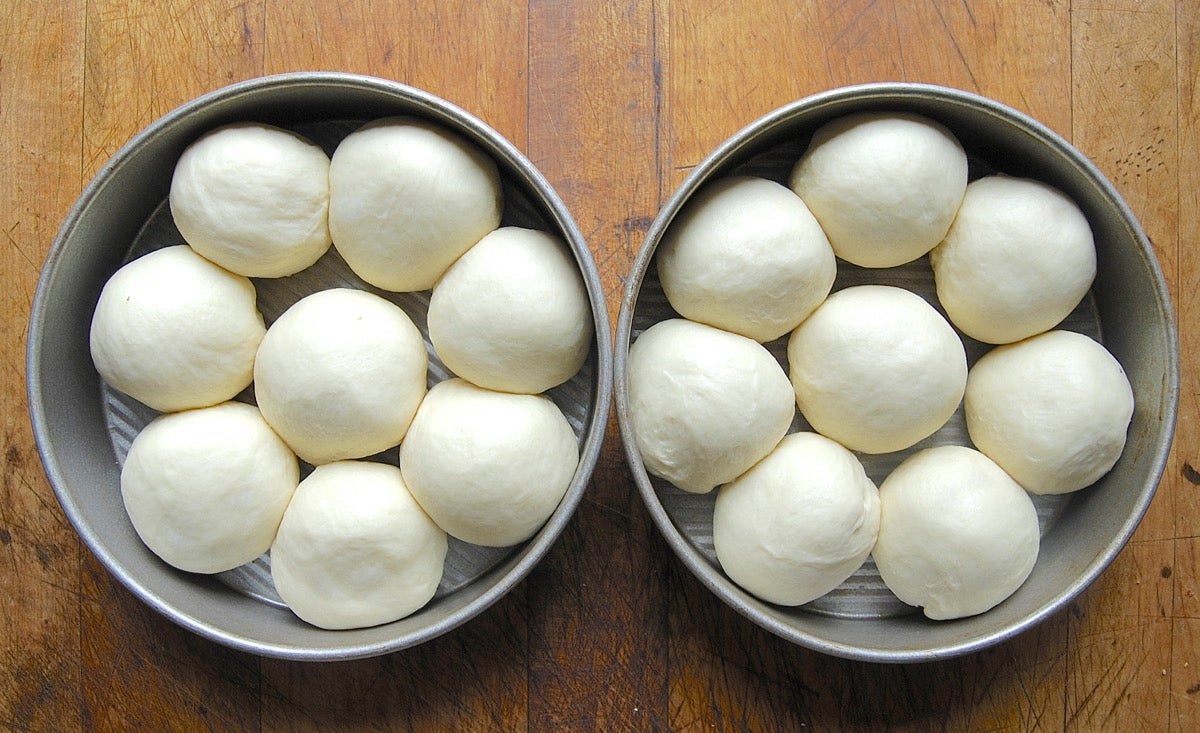
Does the ideal internal temperature change with the size of the bread? Let's bake these Golden Pull-Apart Butter Buns and find out.
The recipe calls for buns to bake for 22 to 24 minutes, until golden brown.
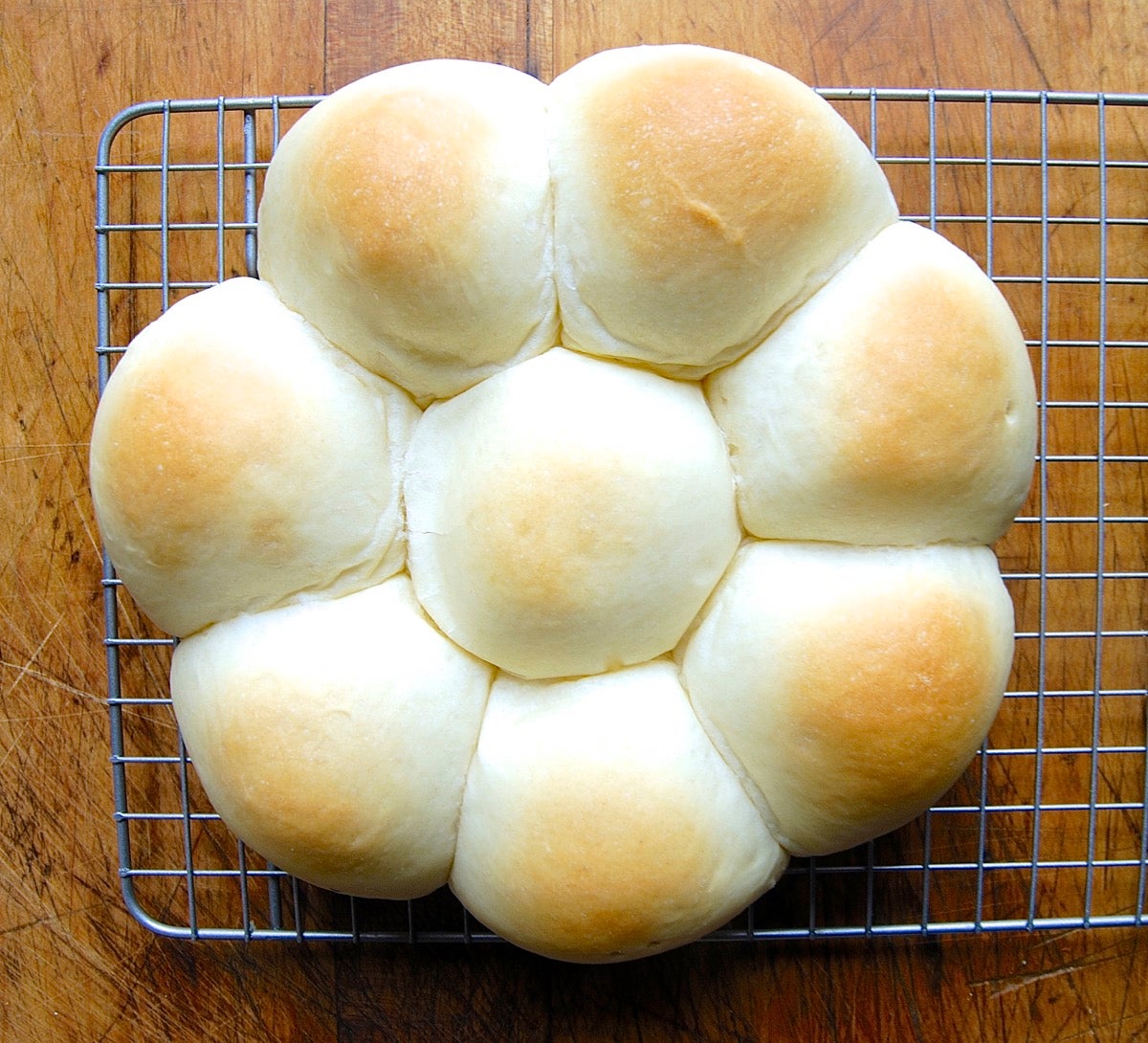
I decide to start taking their temperature at 15 minutes. At this point, as you can see, they're barely browned. Yet the interior temperature of one of the buns on the edge is already 192°F, while the center bun is just 171°F.
I take the buns out of the oven. Meanwhile, I bake the other pan of buns for 5 more minutes — a total of 20 minutes.

The 20-minute buns (right) are light golden brown. An outside bun registers 208°F, while the center bun is 199°F — well above the 190°F proving ideal for other breads.
So we have four different finish temperatures to evaluate with these buns: 171°F and 192°F from the first pan; and 199°F and 208°F from the second pan.
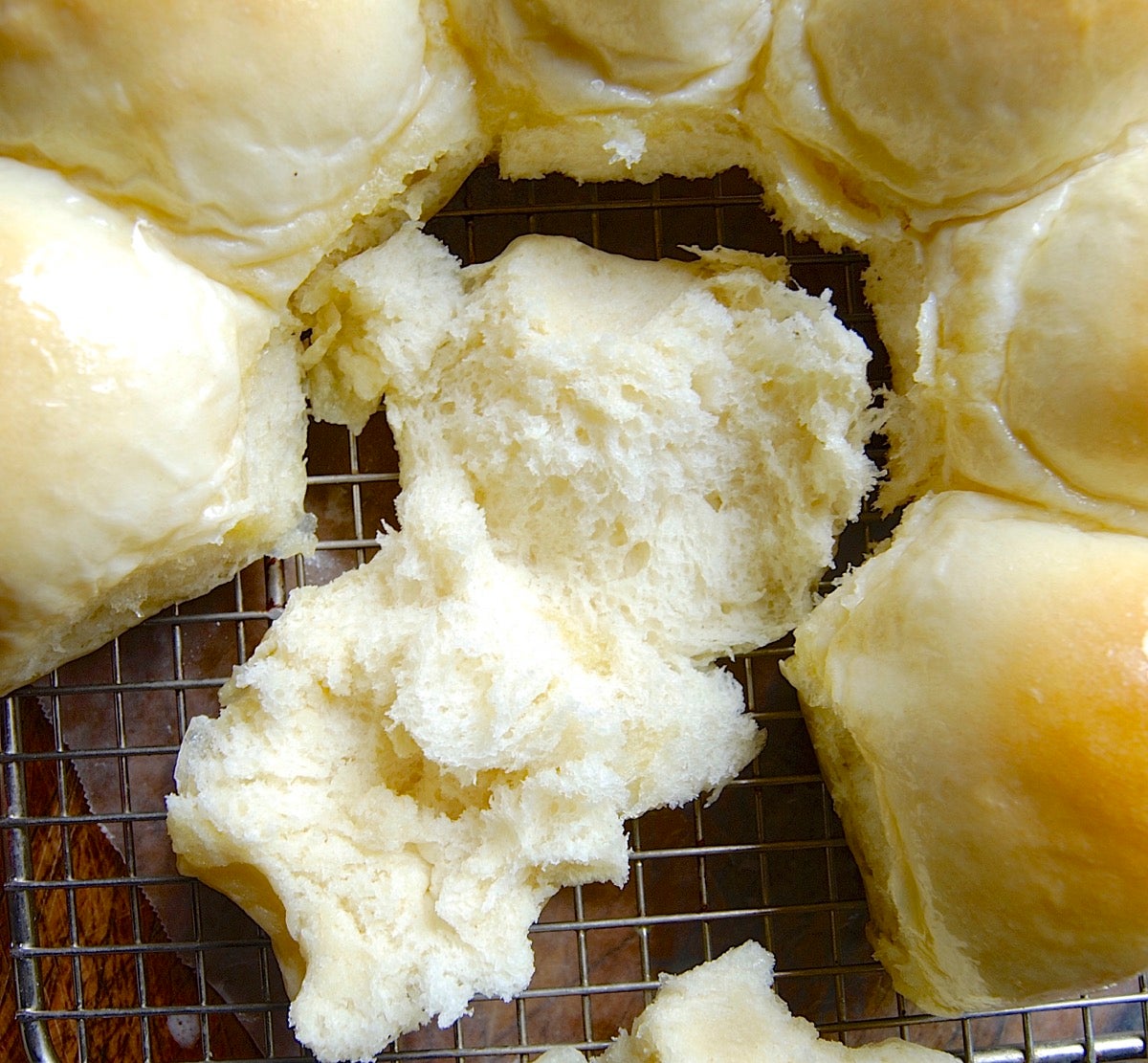
Predictably, the 171°F bun is very soft and tender and moist. It's not gummy, but it is VERY fragile; squeeze a piece in your fingers, and it turns into a dough ball.
The remaining hot buns are uniformly delicious.

Notice I said "hot," though. The big difference is apparent once the buns cool. All slice nicely; all exhibit fully baked interiors. But the buns from the first pan (the pale buns) are still soft, tender, and moist at room temperature; while the buns from the second pan (the ones with nicely browned tops) are somewhat dry and tough.
The less-baked buns remain moist for several days at room temperature, while the buns baked longer become progressively drier.
Verdict: If you're serving buns hot from the oven, bake them until light brown. If you're planning on serving them at room temperature — or reheating them — bake them only until they're pale gold, and their interior temperature doesn't rise higher than 190°F or so.
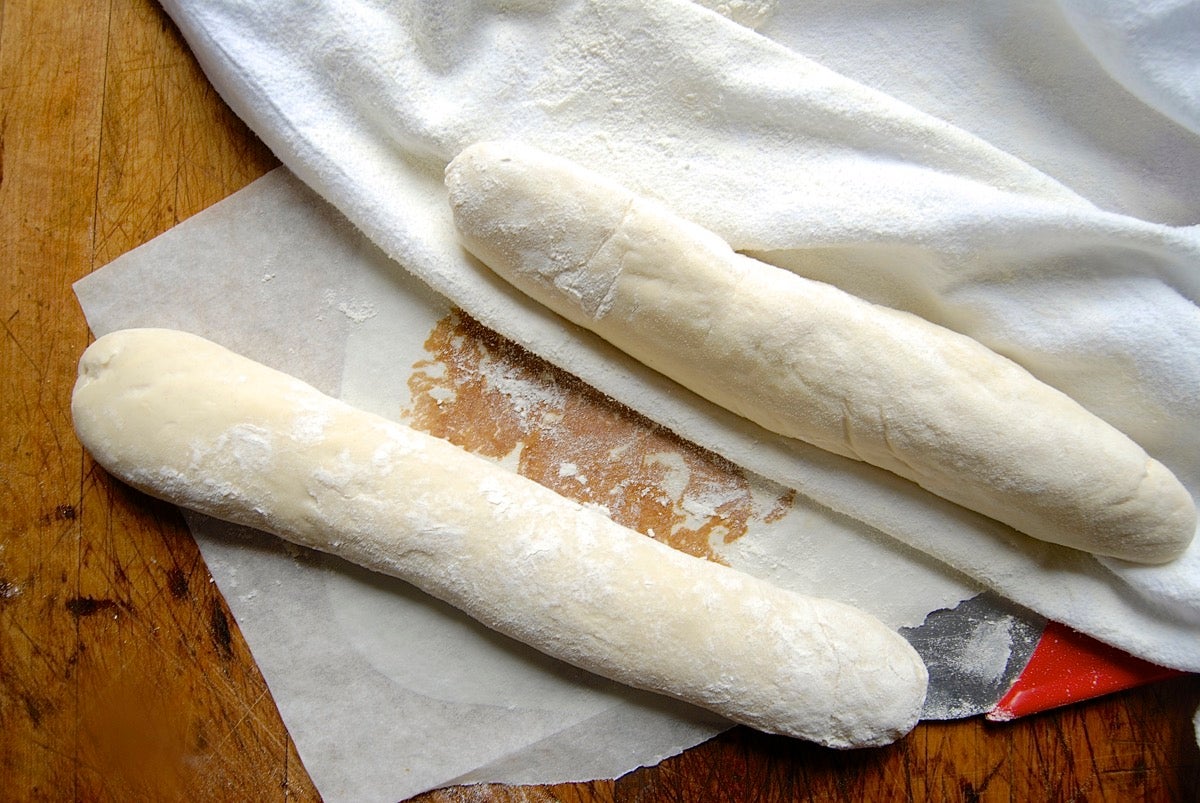
My final test is a bread that's at the opposite end of the texture spectrum from soft dinner rolls: crisp/chewy baguettes. I use our Classic Baguette recipe to discover the optimum way to bake the ideal crusty baguette.
First, I rethink my expectations. Do I want a baguette with a soft, moist center? No; I want a center that's fairly dry, chewy, and filled with large holes: typical baguette texture.
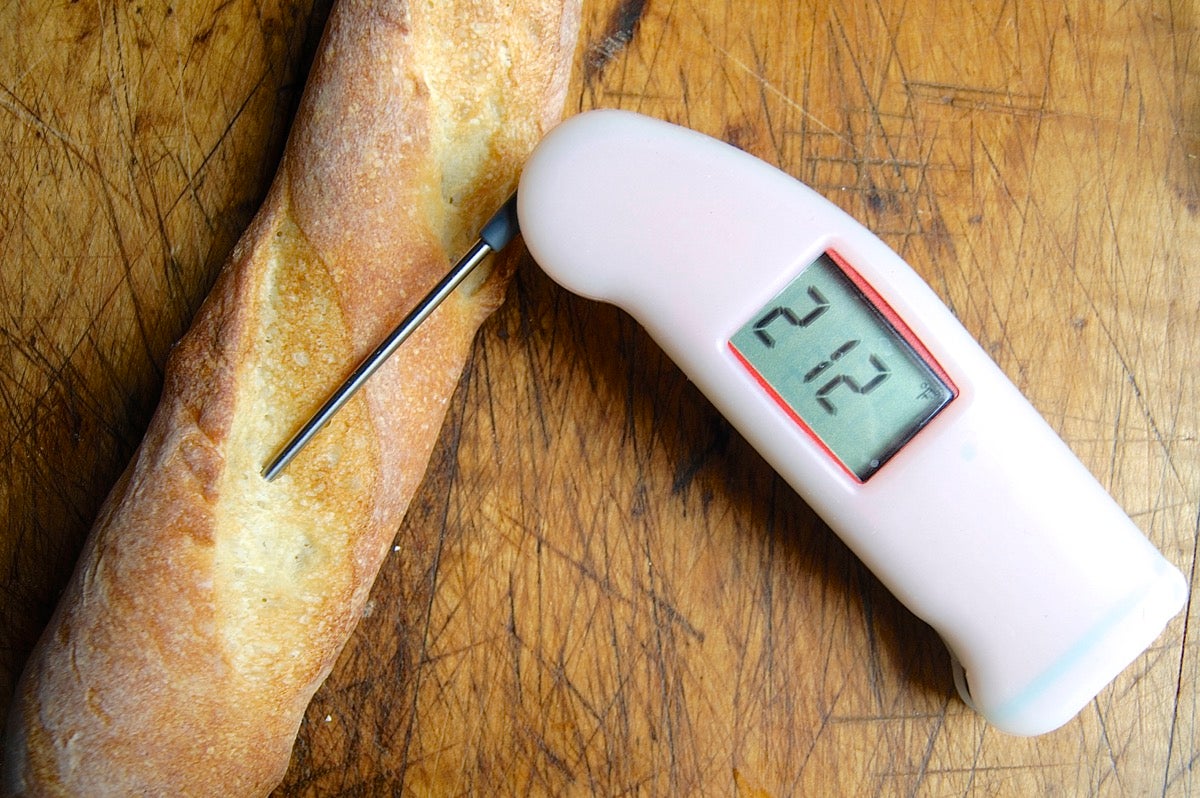
So rather than evaluating baguettes by their internal temperature, I decide to judge them by the darkness of their crust. The recipe calls for baking the loaves for 25 to 30 minutes; I take my first loaf out after 20 minutes, when it's a medium golden brown. Its interior temperature is a whopping 212°F.
I take the next loaf out 5 minutes later: again, its temperature is 212°F. I learn later that bread's interior temperature will never rise above 212°F, since that's the boiling point of water (and the temperature of steam, which water becomes as it evaporates from the loaf).
The remaining loaf I bake the full 30 minutes; it's a very dark golden brown. Once cool, I compare all three loaves: the darker loaves have richer flavor, due to caramelization of the crust. They're also chewier, as their crust is somewhat thicker.
And, just as I found in my other tests, the loaf baked to the lowest temperature retains its moisture longest: which in the case of baguettes isn't a good thing. Moisture in the interior of an under-baked (light-crusted) baguette will migrate outwards, leaving the crust soft and leathery.
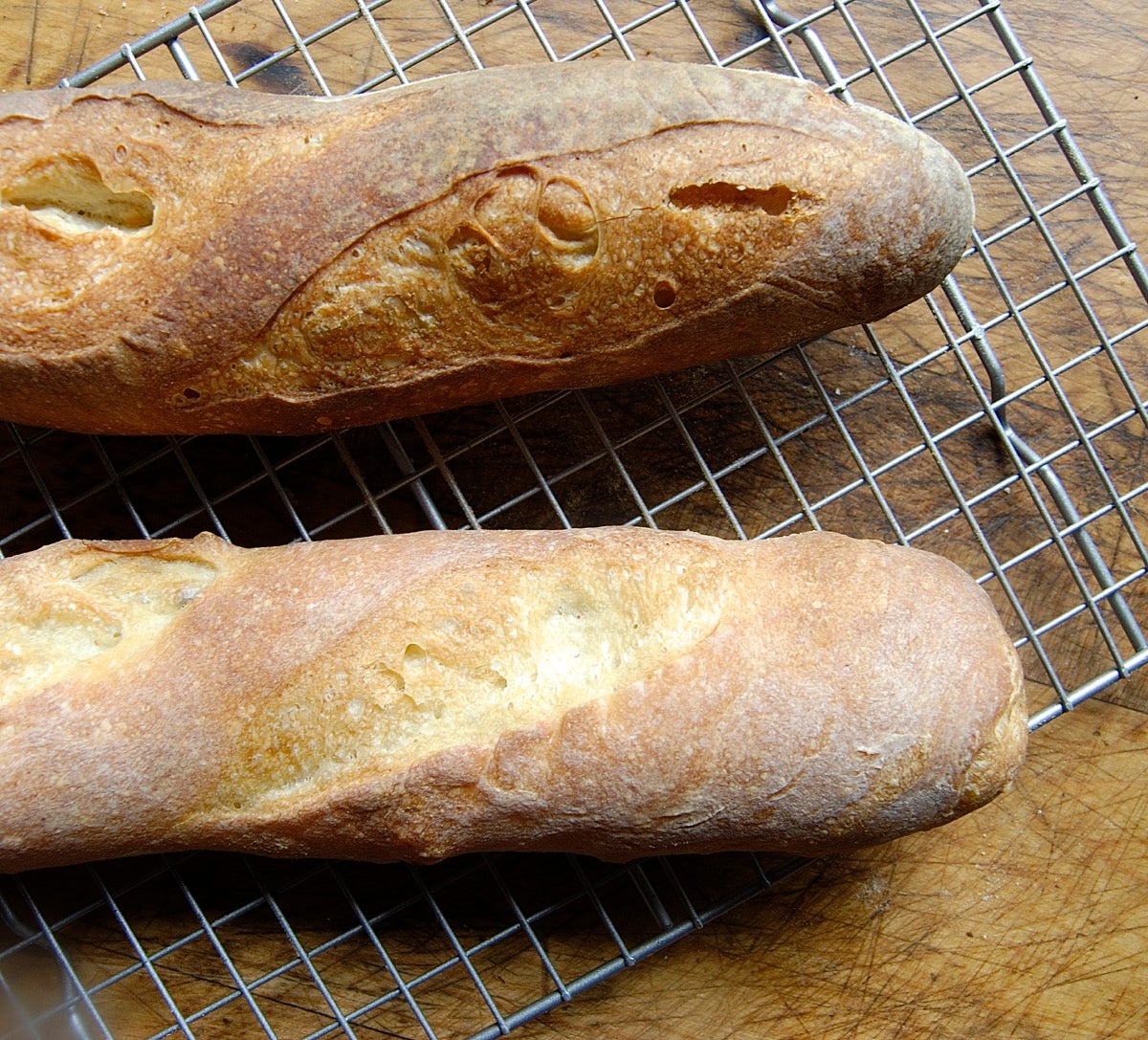
Verdict: You don't need a thermometer to tell if a baguette is fully baked. For best results, simply bake until thoroughly browned. In this case, the color of the crust is more important than the bread's temperature.

Using a thermometer with yeast bread is a reliable way to ensure bread is fully baked. Do you take your bread's temperature? Or are you a devoted "thumper"? Share your bread-testing experiences in comments, below.
February 29, 2024 at 7:28pm
In reply to Hi there, wondering if you… by Lucy (not verified)
Hi Lucy, typically you will want to remove the loaf from the oven before checking the temperature so that all of the hot air does not escape!
January 14, 2024 at 4:59pm
I bake my sour dough bread what temp should they be?
January 18, 2024 at 2:02pm
In reply to I bake my sour dough bread… by Lois (not verified)
Hi Lois, for sourdough we generally recommend baking a little higher, around 205°F to 210°F. With that in mind, it will vary based on the recipe, so remember to use all your senses to determine if bread is done baking. We have a handy guide here: How to tell if bread is done baking.
April 23, 2024 at 11:17am
In reply to Hi Lois, for sourdough we… by ranastopoulo
Can I ask why it's different for sourdough? Is it because hydration is higher for sourdough?
April 23, 2024 at 3:31pm
In reply to Can I ask why it's different… by Andrew (not verified)
Hi Andrew, baking to a slightly higher temperature will help ensure that the bread's center is not gummy or dense.
December 11, 2023 at 9:46pm
I baked 2 loaves of Filoncino Italian-style bread with KAF Bread Flour. At 25 minutes they temped at 207F so I removed them from the oven. They were baked on a Baking Steel. The bottoms are nice and browned and crusty but the rest of the loaves have almost no color. Why is that? I feel if left to bake any longer to achieve more color the bottoms would have burnt. Do you have any suggestions on what went wrong and what I should do next time I bake these loaves so they will look more appetizing? Any help/suggestions will be greatly appreciated.
December 13, 2023 at 5:58pm
In reply to I baked 2 loaves of… by Mike Sr. (not verified)
Hi Mike, it is possible that your baking steel heated the bottom of the loaf more quickly than the top of the loaf. Because the top of the loaf was quite pale towards the end of baking, it may be beneficial to move the loaf closer to the top of the oven for a more even bake depending on your oven. We are always happy to help assist you further on our Baker's Hotline at (855) 371-2253 (BAKE). Happy Baking!
November 27, 2023 at 7:54pm
You blew my mind by stating that the internal temperature of bread will never rise above 212F. So fascinating! I’ve been baking since I was a kid, but just recently started baking bread and it is truly science, even more than cakes and cookies. Thank you for your well written recipes and all the efforts your bakers go to to help us home bakers!
December 1, 2023 at 9:31am
In reply to You blew my mind by stating… by Carol (not verified)
You're very welcome, Carol!
December 5, 2023 at 9:32am
In reply to You're very welcome, Carol! by balpern
Interesting info, but there is a critical piece of information missing: the temperature of the oven. Did you bake at 375 F, 400F, 450F or 500F it is important to know . Temp of oven and time in the oven are NOT independent variants. And I will not even mention the humidity of the environment!
Pagination